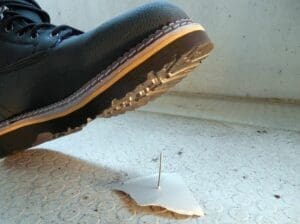Negligence in Tort law
What is the definition of negligence in tort law within Israel? This legal concept might be unclear or confusing as to what cases are included under it. Those not proficient in the legal language or unable to read Hebrew might confuse cases of negligence with other tort liability. Our law firm is here to explain what negligence is, give examples, and clarify the components of negligence.
What is negligence?
Negligence as defined in Israeli tort law is explained in Section 35 of the Torts Ordinance, constituting a “general wrongdoing,” which includes an unlimited number of cases under its legal definition. According to the law, negligence is a situation in which a person has acted or failed to act in a manner not expected from a reasonable and intelligent person, and following such behavior, have caused damage to another person. This definition also includes cases where a certain professional has acted or failed to act in a manner expected from a professional in the same field, or even cases where an entity or a person have violated their duty to act or not to act in a certain manner towards another person.
As opposed to other torts in torts law, the plaintiff does not have to prove that the defendant intended to do harm.

How do you prove the tort of negligence?
In order to prove the tort of negligence, the plaintiff necessarily has to have suffered damage, and must prove that the defendant’s behavior caused this damage, rather than any other reason.
The plaintiff must prove three elements:
- The existence of duty of care on the part of the defendant;
- The violation of the duty of care;
- The damage caused to the plaintiff due to the violation of the defendant’s duty of care.
For example, a tort of negligence might exist with respect to a person who had a unstable tree in their private yard, that fell on another person and caused them physical damage, since it wasn’t pruned on time and was neglected. However, if the tree fell and hurt another person due to severe weather conditions, the person who owns the tree bears no liability. This is because a reasonable and intelligent person could not have prevented the tree’s fall through standard actions that they were able to perform.
Similarly, municipalities have a responsibility to care for the maintenance of public facilities. If a municipality ignored complaints, or failed to handle unstable trees in its jurisdiction, it will bear liability for the damage caused to the person hurt by a falling tree. However, if the tree hurt a person after the municipality has performed regular checkups, maintenance, and addressed resident complaints, it would be difficult to prove that the municipality has acted in an unreasonable manner and caused the damage through its actions.
A negligence suit can also be filed against private entities, especially those of a public nature, such as malls. In case a mall was negligent in regular maintenance or failed to act in order to deter or remove a hazard, the injured party might have the right to receive financial compensation. Two common cases are fall or slip-and-fall accidents in malls, which have caused physical damage.
How can you prove the defendant’s compliance with the duty of care?
Section 36 of the law applies the duty to act in a reasonable manner to any person or entity which, under the circumstances of the matter, might have expected the occurrence of the damage in the chain of events that took place. “Reasonable and intelligent” behavior is examined by comparing the situation to other cases, where unreasonable behavior is a situation in which another person in similar circumstances would have acted differently from the way the defendant behaved. For example, the plaintiff and their lawyer would have to ask whether municipalities are expected to perform regular inspections of public facilities in their jurisdiction, and whether the defendant municipality has failed to do so. Would another person have acted more carefully in similar circumstances?
Common duties of responsibility, which do not require the plaintiff to prove the existence of duty of care, include employers responsible for ensuring their employees’ safety, medical professionals responsible for ensuring their patients’ safety, or municipalities responsible for inspecting and removing public hazards.
What is damage?
Damage is defined in Section 2 of the Torts Ordinance as:
“Loss of life, loss or detriment to property, comfort, bodily welfare, reputation or other similar loss or detriment.”
A person who was injured or suffered damage (the injured party) may file suit against the person who caused the damage (the tortfeasor). The damage must detrimentally affect the person, physically or financially, and it is not enough to only prove the existence of the hazard.
Financial damage can be interpreted broadly, for example a vehicle damaged due to a pothole or the incursion of a public structure into private property. In contrast, bodily damage constitutes physical injury caused to the person themselves as a result of the hazard. One classic example for a case of negligent bodily damage is a fall injury caused by a hazard within the municipality’s or the local authority’s jurisdiction.
The damage should not necessarily be severe; however the severity and scope of the damage might affect the amount of compensation awarded by the court.
Municipal negligence
The Municipalities Ordinance regulates municipalities’ responsibility for maintaining the city’s streets, removing hazards, guaranteeing good sanitation, and even taking safety measures against accidents in public areas.
If a municipality or a local authority have violated their duty to ensure the above, it might be that a person injured as a result of such behavior would have the right to receive financial compensation for the damage caused to them.
Typical examples for this include flood damages caused by negligence or by ignoring residents’ complaints, fall accidents due to sinkhole in the sidewalk or a hazard endangering pedestrians, or any injury caused by an object under the municipality’s responsibility in a public area.
Employer negligence
As mentioned above, employers have a specific duty of responsibility to ensure their employees’ safety. However, not every accident that took place at work, or while commuting, would be considered as negligence. If a person was involved in a road accident while commuting to or from work, or if they were physically injured in the workplace despite maintaining security guidelines, this would be considered as a work accident eligible for compensation from the National Insurance Institute.
However, if an employee was injured due to failures of the equipment in the workplace, or the employer’s non-compliance with the safety procedures expected from it, or due to unsafe physical and emotional working conditions, it might be that the injured party would have the right to receive compensation for negligence, alongside compensation for a work accident.
Medical malpractice
Medical malpractice is a type of professional negligence that can apply with regards to any medical professional who acted in an unreasonable manner not expected from them. To prove that a medical professional has acted with negligence, the plaintiff would have to show that this professional has failed to act according to the level of care expected among professionals in their area, and that the damage was caused because of this.
This type of negligence might include the administration of an incorrect dose of anesthesia, causing the plaintiff to wake up in the middle of a surgery, therefore causing emotional damage; a non-consensual surgery that violated a person’s bodily autonomy; and any other case in which a medical professional has failed to act according to established practices in their area.
Compensation
Compensation for property damage is usually intended to restore the injured party’s state to the way it was prior to the damage, and therefore reflects the financial damages caused to the plaintiff. For example, the court could award compensation for the repair of a car that was damaged by a falling tree due to the municipality’s negligence. Such compensations don’t usually include a “punitive” component, intended to compensate the injured party beyond the damage caused to them.
However, the amount of compensation for bodily damage is determined according to to four main types of damage: Loss of earnings, pain and suffering, medical expenses, and care expenses (in case a person needs help to function), and its amount is affected by the injured party’s age and the disability rate determined for them, or alternatively, the financial cost of necessary medical care, and the future ramifications of the damage.
A suit filed against municipalities or local authorities might also lead to the use of court orders, whose purpose is to cease activities that might lead to damages, and these might be issued in the very beginning of the legal procedure, so long as the court is convinced that the municipality’s negligence is likely to be proved, and that failing to issue the order would increase the injustice suffered by the plaintiff.
In exceptional cases, concerning significant damages, or significant negligence on part of the defendant, the court might also include compensation for emotional components, such as pain and suffering or emotional distress, as established in CA 10/544 Anonymous Vs. Kfar Kassem Municipality. In addition, the compensation also usually includes the legal fees paid to the lawyer.
Contributory negligence
According to Section 68(a) or the Torts Ordinance, the amount of compensation payable to the plaintiff might change, depending on whether the plaintiff has any contributory negligence with respect to the damage. Meaning, the court can reduce the amount of compensation if the plaintiff themselves acted with lack of caution and was responsible for the occurrence of the damage, or part of the damage, caused to them. For example, if the injured party ignored a conspicuous hazard where they were injured, failed to seek medical care following the injury, or has failed to act according to the safety procedures in their workplace.
The defendant carries the burden of proving contributory negligence, and if the court of convinced of such, it will quantify the rate of contributory negligence, and deduct it from the compensation payable to the plaintiff. It should be noted that the court can also determine that the damage was fully caused by the plaintiff, and therefore no compensation will be awarded.
What should you do once damage has occurred?
Before consulting a torts lawyer and proving negligence to receive compensation, you should gather all information relevant to the event. Pictures from the place where the damage occurred, medical documents, the details of eye witnesses, letters showing complaints from residents, and more…
Due to the complexity of the tort of negligence and the difficulty to prove the defendant’s causation of the damage, it’s important to seek the assistance of an experienced lawyer specializing in torts law.
Our law firm, located in Jerusalem and Tel Aviv, specializes in torts law, with proven experience in negligence suits. We’ll be happy to assist you.
מאמרים מומלצים

